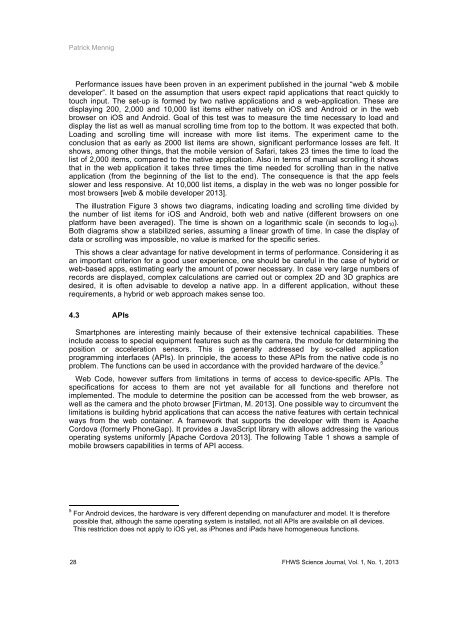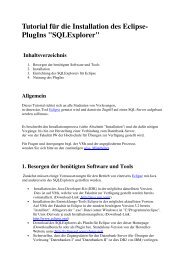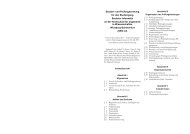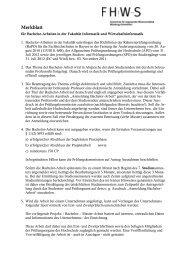FHWS Science Journal - Fakultät Informatik und Wirtschaftsinformatik
FHWS Science Journal - Fakultät Informatik und Wirtschaftsinformatik
FHWS Science Journal - Fakultät Informatik und Wirtschaftsinformatik
You also want an ePaper? Increase the reach of your titles
YUMPU automatically turns print PDFs into web optimized ePapers that Google loves.
Patrick Mennig<br />
Performance issues have been proven in an experiment published in the journal “web & mobile<br />
developer”. It based on the assumption that users expect rapid applications that react quickly to<br />
touch input. The set-up is formed by two native applications and a web-application. These are<br />
displaying 200, 2,000 and 10,000 list items either natively on iOS and Android or in the web<br />
browser on iOS and Android. Goal of this test was to measure the time necessary to load and<br />
display the list as well as manual scrolling time from top to the bottom. It was expected that both.<br />
Loading and scrolling time will increase with more list items. The experiment came to the<br />
conclusion that as early as 2000 list items are shown, significant performance losses are felt. It<br />
shows, among other things, that the mobile version of Safari, takes 23 times the time to load the<br />
list of 2,000 items, compared to the native application. Also in terms of manual scrolling it shows<br />
that in the web application it takes three times the time needed for scrolling than in the native<br />
application (from the beginning of the list to the end). The consequence is that the app feels<br />
slower and less responsive. At 10,000 list items, a display in the web was no longer possible for<br />
most browsers [web & mobile developer 2013].<br />
The illustration Figure 3 shows two diagrams, indicating loading and scrolling time divided by<br />
the number of list items for iOS and Android, both web and native (different browsers on one<br />
platform have been averaged). The time is shown on a logarithmic scale (in seconds to log 10 ).<br />
Both diagrams show a stabilized series, assuming a linear growth of time. In case the display of<br />
data or scrolling was impossible, no value is marked for the specific series.<br />
This shows a clear advantage for native development in terms of performance. Considering it as<br />
an important criterion for a good user experience, one should be careful in the case of hybrid or<br />
web-based apps, estimating early the amount of power necessary. In case very large numbers of<br />
records are displayed, complex calculations are carried out or complex 2D and 3D graphics are<br />
desired, it is often advisable to develop a native app. In a different application, without these<br />
requirements, a hybrid or web approach makes sense too.<br />
4.3 APIs<br />
Smartphones are interesting mainly because of their extensive technical capabilities. These<br />
include access to special equipment features such as the camera, the module for determining the<br />
position or acceleration sensors. This is generally addressed by so-called application<br />
programming interfaces (APIs). In principle, the access to these APIs from the native code is no<br />
problem. The functions can be used in accordance with the provided hardware of the device. 5<br />
Web Code, however suffers from limitations in terms of access to device-specific APIs. The<br />
specifications for access to them are not yet available for all functions and therefore not<br />
implemented. The module to determine the position can be accessed from the web browser, as<br />
well as the camera and the photo browser [Firtman, M. 2013]. One possible way to circumvent the<br />
limitations is building hybrid applications that can access the native features with certain technical<br />
ways from the web container. A framework that supports the developer with them is Apache<br />
Cordova (formerly PhoneGap). It provides a JavaScript library with allows addressing the various<br />
operating systems uniformly [Apache Cordova 2013]. The following Table 1 shows a sample of<br />
mobile browsers capabilities in terms of API access.<br />
5 For Android devices, the hardware is very different depending on manufacturer and model. It is therefore<br />
possible that, although the same operating system is installed, not all APIs are available on all devices.<br />
This restriction does not apply to iOS yet, as iPhones and iPads have homogeneous functions.<br />
28 <strong>FHWS</strong> <strong>Science</strong> <strong>Journal</strong>, Vol. 1, No. 1, 2013








